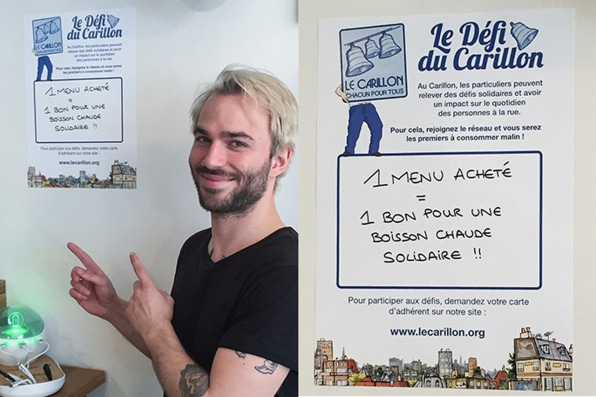Thanks to easy-to-understand pictograms, which allow to overcome language barriers, small business owners indicate on their shop window what kind of services they can offer, and at what time. Enabling the business owners to customize services and time is key to engage them and ensure homeless people are effectively welcome. Such a system helps every business owner to easily engage in the fight against social inclusion; it also reverses a well-anchored typical tendency in which the homeless are not the ones going towards the “mainstream society” out of fear of being rejected.
In addition, Louis-Xavier works hand in hand with social work organizations, such as local unities of the Red Cross, Les Restos du Coeur or Emmaüs, and other social structures to reach the homeless with information about Le Carillon, how it works and the location of small businesses that are part of the network.
1 Start in your own neighborhood.
2 Create a label to identify the small businesses willing to open their doors to offer what they can to the homeless.
3 Build around these small local business owners a wider community involving local residents to help with the management and development of this inclusive network.
The network’s management includes the organization of monthly events where residents and homeless people meet and spend time together in one of the labeled local shop without making any distinction between “helpers” and “helped people”.
Local residents have different opportunities to engage: they can either volunteer to locally operate the follow-up of the different labeled small businesses and organize events, or take up “consumer challenges” by consuming in the labeled small local businesses to obtain consumer coupons they can offer to the homeless people they meet.
In addition, Louis-Xavier made sure to offer the homeless the opportunity to take up on an active role to maintain and develop the community. As “neighborhood ambassadors”, they can be involved in communication towards other homeless people or endorse the role of mystery customers to test the recently labeled small business owners and make sure they are not interested in the label only to spin a good line with usual customers; they can also be active contributors of a new type of local events gathering the local community, such as soup kitchens in which they are the ones serving food to their neighbors. More importantly, Louis-Xavier encourages the homeless to take responsibilities along with other citizens in the local steering committees that pilot the network’s units (follow-up, organization of monthly events, etc.).
By embedding the social inclusion matter in the citizen’s everyday life, and giving the opportunity to the homeless to be an active contributor in the community, Le Carillon’s model provokes a significant mindset shift both in the citizens’ thinking about their role of changemakers, as well as in the way homeless people see themselves.

